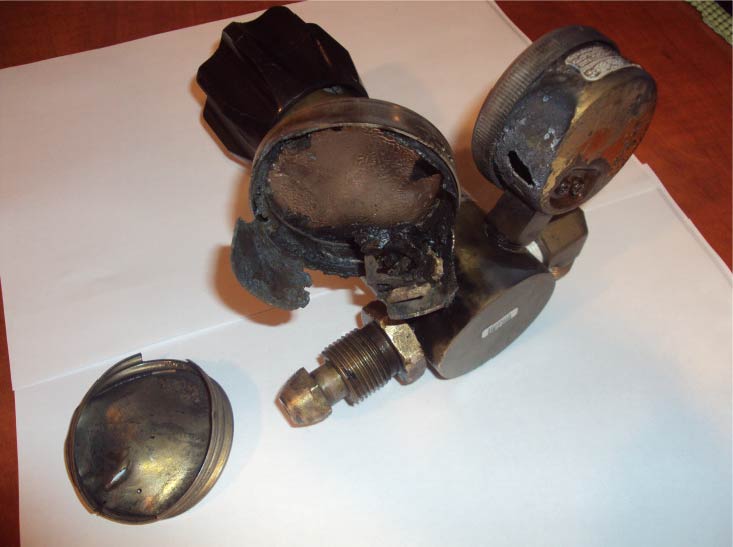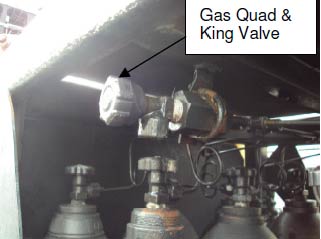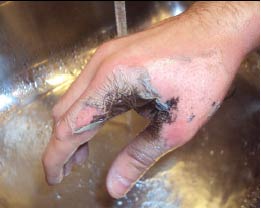Oxygen regulator explodes causing injury
A member has reported an incident in which an oxygen regulator exploded when the oxygen was turned on, causing a second degree burn injury to someone’s hand. The incident occurred during the changeover of high pressure (HP) oxygen diving gas quads. The gasman was tasked with going on deck to change over a supply of oxygen from one gas quad to another. Company procedures for isolating the oxygen quad, venting the line, disconnection of the regulator and then reconnection onto the new quad were all carried out correctly. Once the regulator was reconnected onto the new gas quad the gasman turned on all 16 individual bottle valves. He then ensured the oxygen regulator was fully wound back and then proceeded to open the King Valve to allow the oxygen to flow into the regulator. It was during this process of turning the King Valve and releasing oxygen at 200 bar into the regulator that the explosion took place.
After the explosion it was not possible to isolate the escaping oxygen from the King Valve due to possible damage to the valve seat. Each of the 16 individual cylinders then had to be turned off to isolate the flow of oxygen.



Following investigation, the following points were noted:
- Unsuitable personal protective equipment (PPE) was worn for the task. A glove which would restrict heat exchange to the skin would have been more suitable, and consideration should be given to the use of a full face mask;
- Possibility that there may have been some debris or substance such as grease or oil left in the King Valve by the supplier prior to delivery to the vessel;
- The practice of opening all 16 cylinders at once proved to be hazardous in isolating the flow of escaping oxygen.
The following actions were put in place:
- Ensure all connection points are free from grease, oil and dirt prior to connecting any regulators or hoses;
- Ensure oxygen storage areas are sited such that they will not be contaminated with oil or grease, for example beneath an ROV platform;
- Conduct checks of all in use and serviceable regulators used for transfer of oxygen, including those not connected with diving, for example deck welding/burning operations;
- The risk assessment for the connection and disconnection of gas quads and equipment should be suitable and sufficient, and should be understood by all; . The following revised procedure was developed for connecting to an oxygen quad:
- remove supplier’s dust cap
- crack King Valve to confirm there is no pressure behind the valve
- open King Valve and install regulator for gauging and analyses
- confirm regulator is backed off
- the first cylinder is to be opened with the technician standing to the side or rear of the quad
- allow pressure to equalize slowly in the manifold and proceed to open remainder of cylinders.
Safety Event
Published: 16 September 2011
Download: IMCA SF 10/11
IMCA Safety Flashes
Submit a Report
IMCA Safety Flashes summarise key safety matters and incidents, allowing lessons to be more easily learnt for the benefit of all. The effectiveness of the IMCA Safety Flash system depends on Members sharing information and so avoiding repeat incidents. Please consider adding safetyreports@imca-int.com to your internal distribution list for safety alerts or manually submitting information on incidents you consider may be relevant. All information is anonymised or sanitised, as appropriate.
IMCA’s store terms and conditions (https://www.imca-int.com/legal-notices/terms/) apply to all downloads from IMCA’s website, including this document.
IMCA makes every effort to ensure the accuracy and reliability of the data contained in the documents it publishes, but IMCA shall not be liable for any guidance and/or recommendation and/or statement herein contained. The information contained in this document does not fulfil or replace any individual’s or Member's legal, regulatory or other duties or obligations in respect of their operations. Individuals and Members remain solely responsible for the safe, lawful and proper conduct of their operations.
